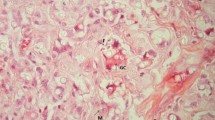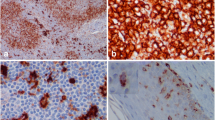Abstract
We used light and electron microscopic immunocytochemistry to study distributional changes in the human Langerhans cell (LC) system during the first 14 days of a mild irritancy caused by sodium lauryl sulphate (SLS). A marked initial decrease in epidermal LC was noted possibly resulting from migration from the epidermis to the dermis and from irreversible cell damage. Several studies have previously found an unchanged number of LC in SLS-induced contact irritant dermatitis, but these studies may not have taken into account the fact that SLS is effectively absorbed from the test chamber. Unless certain precautions are taken the SLS concentration rapidly falls to topical levels that have no effect on the LC system. Simultaneously with the decrease in the epidermis we observed an increase in dermal CD1a+ cells, confirming an often reported finding. There is, however, no consensus as to the identity of these cells, and several authors have reported that such cells lack LC granules and thus these cells have often been classed as indeterminate cells. We found that, during irritant contact dermatitis, provided an adequate number of sections were scrutinized in the electron microscope, all dermal CD1+ cells contained Birbeck granules.
Similar content being viewed by others
References
Willis CM, Young E, Brandon DR, Wilkinson JD (1986 Immimopathological and ultrastructural findings in human allergic and irritant dermatitis. Br J Dermatol 115: 305–316
Mikulowska A (1990) Reactive changes in the Langerhans cells of human skin caused by occlusion with water and sodium lauryl sulphate. Acta Derm Venereol (Stockh) 70: 468–473
Mikulowska A, Bartosik B, Andersson A (1988) Microfocussed distribution of reactive events in the epidermal Langerhans cell system. In: Thivolet J, Schmitt D (eds) The Langerhans cell. Colloque INSERM/John Libbey Ltd. 172 : 285–289
Brand CU, Hunziker T, Limat A, Braathen LR (1993) Large increase of Langerhans cells in human skin lymph derived from irritant contact dermatitis. Br J Dermatol 128: 184–188
Willis CM, Stephens CJM, Wilkinson JD (1990) Differential effects of structurally unrelated chemical irritants on the density and morphology of the epidermal CD1+ cells. J Invest Dermatol 95: 711–716
Mikulowska A (1992) Reactive changes in human epidermis following simple water occlusion. Contact Dermatitis 26: 224–227
Christensen OB, Daniels TE, Maibach HI (1986) Expression of OKT6 antigen by Langerhans cells in patch test reaction. Contact Dermatitis 14: 26–31
Andersson A (1985) A rapid fixation technique of epidermis for electron microscopy. Acta Derm Venereol (Stockh) 65: 539–543
Mikulowska A, Andersson A, Bartosik J, Falck B (1988) Cytomembrane-sandwiching in human epidermal Langerhans cells: A novel reaction to an irritant. Acta Derm Venereol (Stockh) 68: 254–261
Bartosik J, Lamm CJ, Falck B (1991) Quantification of Birbeck's granules in human Langerhans cells. Acta Derm Venereol (Stockh) 71: 209–213
Willis CM, Stephens CJM, Wilkinson JD (1992) Differential effect of structurally unrelated chemical irritants on the density of proliferating keratinocytes in 48 h patch test reaction. J Invest Dermatol 99: 449–153
Willis CM, Stephens CJM, Wilkinson JD (1993) Differential patterns of epidermal leukocyte infiltration in patch test reactions to structurally unrelated chemical irritants. J Invest Dermatol 101: 364–370
Avnstorp C, Ralfkier E, Jorgensen J, Wantzih GL (1986) Sequential immunophenotypical study of lymphoid infiltrate in allergic and irritant reactions. Contact Dermatitis 16: 239–245
Marks JG, Zaino RJ, Bressler MF, et al (1987) Changes in lymphocyte and Langerhans cell population in allergic and irritant contact dermatitis. Int J Dermatol 26: 354–357
Ferguson J, Gibbs JH, Swanson Beck J (1985) Lymphocyte subsets and Langerhans cells in allergic and irritant patch test reactions: histometric studies. Contact Dermatitis 13: 166–174
Brasch J, Burgard J, Sterry W (1992) Common pathogenic pathways in allergic and irritant contact dermatitis. J Invest Dermatol 98: 166–170
Lindberg M, FÄrm G, Scheynius A (1990) Differential effects of sodium lauryl sulphate and non-anoic acid on the expression of CDla and ICAM-1 in human epidermis. Acta Derm Venereol (Stockh) 71: 384–388
Falck B, Andersson A, Elofsson R, Sjöborg S (1981) New views on epidermis and its Langerhans cell in normal state and in contact dermatitis. Acta Derm Venereol Suppl (Stockh) 99: 3–27
Andersson L, Bartosik J, Bendsoe N, et al (1988) Formation and unzipping of Birbeck granules in vitro. In: Thivolet J, Schmitt D (eds) The Langerhans cell, vol 172. John Libbey Eurotext, London, pp 285–289
Gawkrodger DJ, McVittie E, Carr MM, et al (1986) Phenotypic characterization of the early cellular response in allergic and irritant contact dermatitis. Clin Exp Immunol 66: 590–598
Scheynius A, Fischer T, Forsum U, Klareskog L (1984) Phenotypic characterization in situ of inflammatory cells in allergic and irritant dermatitis in man. Clin Exp Immunol 55: 81–90
Murphy GF, Bahn AK, Harrist TJ, Mihm MC (1983) In situ identification of T6-positive cells in normal human dermis by immunoelectron microscopy. Br J Dermatol 108: 423–431
Gawkrodger DJ, Haftek M, Botham PA, et al (1989) The hapten in contact hypersensitivity to dinitrochlorobenzene: immunoelectron microscopic and immunofluorescent studies. Dermatologica 178: 126–130
Carr MM, Botham PA, Gawkrodger DJ, et al (1984) Early cellular reactions induced by dinitrochlorobenzene in sensitized human skin. Br J Dermatol 110: 637–641
Andersson A, Sjöborg S, Elofsson R, Falck B (1981) The epidermal indeterminate cell — a special celltype? Acta Derm Venereol Suppl (Stockh) 99: 41–48
Schuler S, Romani N, Stössel H, Wolff K (1991) Structural organization and biological properties of Langerhans cells. In: Schuler G (ed) Epidermal Langerhans cell. CRC Press, Boca Raton, pp 87–137
Romani N, Lenz A, Glassel H, et al (1989) Cultured human Langerhans cells resemble lymphoid dendritic-cells in phenotype and function. J Invest Dermatol 93: 600–609
Silberberg I, Baer RL, Rosenthal SA (1976) The role of Langerhans cells in allergic contact hypersensitivity. A review of findings in man and guinea pigs. J Invest Dermatol 66: 210–217
Kimber I, Cumberbatch M (1992) Stimulation of Langerhans cell migration by tumour necrosis factor α (TNFα). J Invest Dermatol 99: 48S-50S
Piguet PF, Grau GE, Hauser C, Vassalli P (1991) Tumour necrosis factor is a critical mediator in hapten-induced irritant and contact hypersensitivity reaction. J Exp Med 173: 673–679
Enk AH, Katz SI (1992) Early molecular events in the induction phase of contact sensitivity. Proc Natl Acad Sci USA 89: 1398–1402
Haas J, Lipkow T, Mohammadzadeh M, Kolde G, Knop J (1992) Induction of inflammatory cytokines in murine keratinocytes upon in vivo stimulation with contact sensitizers and tolerizing analogues. Exp Dermatol 1: 76–83
Oxholm A, Oxholm P, Avnstorp C, Bendtzen K (1991) Keratinocyte-expression of interleukin-6 but not tumour necrosis factor-alpha is increased in the allergic and the irritant patch test reaction. Acta Derm Venereol (Stockh) 71: 93–98
Hunziker T, Brand CU, Kapp A, Waelt ER, Braathen LR (1992) Increased levels of inflammatory cytokines in human skin lymph derived from sodium lauryl sulphate-induced contact dermatitis. Br J Dermatol 127: 254–257
Author information
Authors and Affiliations
Rights and permissions
About this article
Cite this article
Mikulowska, A., Falck, B. Distributional changes of Langerhans cells in human skin during irritant contact dermatitis. Arch Dermatol Res 286, 429–433 (1994). https://doi.org/10.1007/BF00371567
Received:
Issue Date:
DOI: https://doi.org/10.1007/BF00371567




